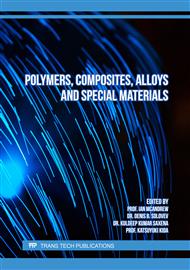p.3
p.9
p.17
p.23
p.29
p.35
p.43
p.55
Effect of Addition Amount of Surface Treated Wood Flour on Moisture Absorption Property of Green Composite
Abstract:
This study was examined the moisture absorption property of green composite using surface treated wood flour for sustainable development goals (SDGs) of product. Constituent materials of green composite were Japanese cedar flour and poly (lactic acid). The lumber of Japanese cedar was cut by hand saw for wood flour. The surface treatment of wood flour was conducted by stone mill. The number of cycle was 400 cycles. The maximum addition amount of wood flour was 20wt%. Molding method of green composite was vacuum compressive method. The moisture absorption test of green composite was conducted by using KNO3 solution. The maximum test time was four weeks (672 hours). The environmental temperature was room temperature. The humidity was 93%. As a result, following conclusions were obtained. In case of test time 672 hours, coefficient of moisture absorptions of green composites using non and surface treated wood flour 1.0wt.% were similar to that of poly (lactic acid). But, the coefficient of moisture absorption of green composite using surface treated Japanese cedar flour 20wt.% was larger than that of green composite using non-treated Japanese cedar flour 20wt.%. The water penetration probably occurred at interface between Japanese cedar flour and matrix. Therefore, the moisture absorption property of green composite using surface treated Japanese cedar flour 20wt% was affected by water penetration at interface between Japanese cedar flour and matrix.
Info:
Periodical:
Pages:
23-27
Citation:
Online since:
April 2023
Authors:
Price:
Сopyright:
© 2023 Trans Tech Publications Ltd. All Rights Reserved
Share:
Citation:



